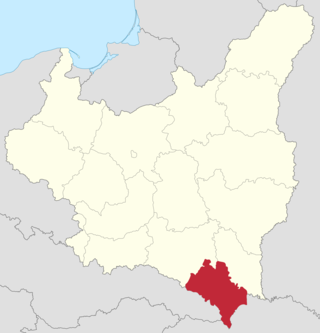Related Research Articles

Kainite ( or ) (KMg(SO4)Cl·3H2O) is an evaporite mineral in the class of "Sulfates (selenates, etc.) with additional anions, with H2O" according to the Nickel–Strunz classification. It is a hydrated potassium-magnesium sulfate-chloride, naturally occurring in irregular granular masses or as crystalline coatings in cavities or fissures. This mineral is dull and soft, and is colored white, yellowish, grey, reddish, or blue to violet. Its name is derived from Greek καινος [kainos] ("(hitherto) unknown"), as it was the first mineral discovered that contained both sulfate and chloride as anions. Kainite forms monoclinic crystals.

Potassium is a chemical element; it has symbol K and atomic number 19. It is a silvery white metal that is soft enough to easily cut with a knife. Potassium metal reacts rapidly with atmospheric oxygen to form flaky white potassium peroxide in only seconds of exposure. It was first isolated from potash, the ashes of plants, from which its name derives. In the periodic table, potassium is one of the alkali metals, all of which have a single valence electron in the outer electron shell, which is easily removed to create an ion with a positive charge. In nature, potassium occurs only in ionic salts. Elemental potassium reacts vigorously with water, generating sufficient heat to ignite hydrogen emitted in the reaction, and burning with a lilac-colored flame. It is found dissolved in seawater, and occurs in many minerals such as orthoclase, a common constituent of granites and other igneous rocks.

Potash includes various mined and manufactured salts that contain potassium in water-soluble form. The name derives from pot ash, plant ashes or wood ash soaked in water in a pot, the primary means of manufacturing potash before the Industrial Era. The word potassium is derived from potash.

Wieliczkapronounced[vʲɛˈlʲit͡ʂka] is a historic town in southern Poland, situated within the Kraków metropolitan area in Lesser Poland Voivodeship since 1999. The town was initially founded in 1290 by Premislaus II of Poland. Nowadays, it is mostly known for the Wieliczka Salt Mine, declared a UNESCO World Heritage Site in 1978, and the historic old town core which was listed as one of National Polish Monuments in 1994. The population in 2019 was estimated at 23,395.

Potassium chloride is a metal halide salt composed of potassium and chlorine. It is odorless and has a white or colorless vitreous crystal appearance. The solid dissolves readily in water, and its solutions have a salt-like taste. Potassium chloride can be obtained from ancient dried lake deposits. KCl is used as a fertilizer, in medicine, in scientific applications, domestic water softeners, and in food processing, where it may be known as E number additive E508.

Bochnia is a town on the river Raba in southern Poland, administrative seat of Bochnia County in Lesser Poland Voivodeship. The town lies approximately halfway 38 kilometres (24 mi) between Tarnów (east) and the regional capital Kraków (west). Bochnia is most noted for its salt mine, the oldest functioning in Europe, built in the 13th century, a World Heritage Site and a Historic Monument of Poland.

Stanisławów Voivodeship was an administrative district of the interwar Poland (1920–1939). It was established in December 1920 with an administrative center in Stanisławów. The voivodeship had an area of 16,900 km2 and comprised twelve counties (powiaty). Following World War II, at the insistence of Joseph Stalin during the Tehran Conference of 1943, Poland's borders were redrawn, Polish population forcibly resettled and Stanisławów Voivodeship was incorporated into the Ukrainian Soviet Socialist Republic as Stanislav Oblast.

Kalush is a city set in the foothills of the Carpathian Mountains, in Ivano-Frankivsk Oblast (province) of western Ukraine. It is the administrative centre of Kalush Raion (district) and hosts the administration of Kalush urban hromada, one of the hromadas of Ukraine. Its estimated population was 65,088.

Potassium superoxide is an inorganic compound with the formula KO2. It is a yellow paramagnetic solid that decomposes in moist air. It is a rare example of a stable salt of the superoxide anion. It is used as a CO2 scrubber, H2O dehumidifier, and O2 generator in rebreathers, spacecraft, submarines, and spacesuits.

Sodium bromate, the inorganic compound with the chemical formula of NaBrO3, is the sodium salt of bromic acid. It is a strong oxidant.

The Khewra Salt Mine, also known as Mayo Salt Mine, is the world's second largest salt mine, located in Khewra, Punjab, Pakistan. The mine is in the Salt Range of the Potohar plateau, which rises from the Indus plain of the Punjab.
Ugartsthal, a former German colony in the Kingdom of Galicia and Lodomeria which is today part of the village Sivka-Kaluska in Kalush Raion, is located 7 km (4 mi) west of Kalush.

The Wieliczka Salt Mine is a salt mine in the town of Wieliczka, near Kraków in southern Poland.

Soledar is a destroyed city in Bakhmut Raion, Donetsk Oblast, Ukraine. Situated in the Donbas region of eastern Ukraine, the city was formerly highly important for its salt mining industry, from which its name Soledar is derived. The last estimate of its population before its destruction was 10,490, in 2022.

Kłodawa is a town in the Koło County in the Greater Poland Voivodeship in central Poland with 6,699 inhabitants (2014).

A salt substitute, also known as low-sodium salt, is a low-sodium alternative to edible salt marketed to reduce the risk of high blood pressure and cardiovascular disease associated with a high intake of sodium chloride while maintaining a similar taste.

FC Kalush was a Ukrainian professional football club from Kalush, Ivano-Frankivsk Oblast.

Żupy krakowskie was a Polish salt mining company which operated continuously from its inception in the 13th century to the late 20th century. It managed salt mines and salt works in two neighboring towns, Wieliczka Salt Mine in Wieliczka and Bochnia Salt Mine in Bochnia, as well as river salt ports on Vistula and, only in the 17th century, a salt work in Dobiegniewo. The company was created circa 1290 by the Polish Crown, thus giving birth to the largest industrial centre in Europe until the 18th century, according to UNESCO, both in terms of the number of employees and its production volumes.

The Kłodawa Salt Mine is the biggest operating salt mine in Poland. It is located in Kłodawa, Koło County, Greater Poland Voivodship.
Chłapowo is a seaside resort and village in the administrative district of Gmina Władysławowo, within Puck County, Pomeranian Voivodeship, in northern Poland. It lies north-west of Władysławowo, approximately 10 km (6 mi) north of Puck, and 50 km (31 mi) north-west of the regional capital Gdańsk. It is located in the ethnocultural region of Kashubia in the historic region of Pomerania on the coast of the Baltic Sea.
References
- ↑ Economic history of Poland, by Andrzej Jezierski, page 284
- ↑ Nesterov, D. Cookies for Alekperov (Пряники для Алєкперова) . Ekonomichna Pravda (Ukrayinska Pravda). 16 November 2012